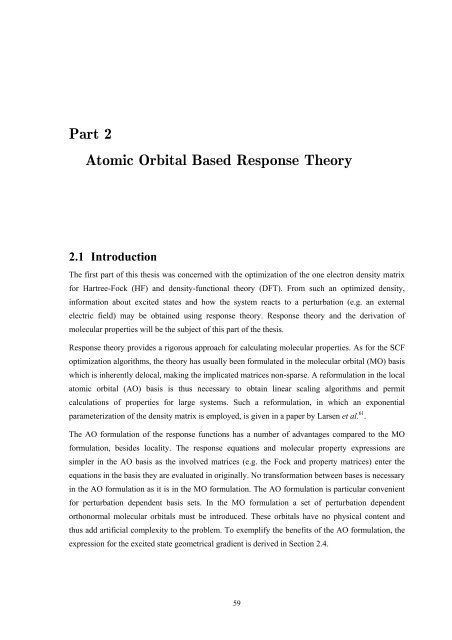Get my PhD Thesis
Get my PhD Thesis
Get my PhD Thesis
You also want an ePaper? Increase the reach of your titles
YUMPU automatically turns print PDFs into web optimized ePapers that Google loves.
Part 2<br />
Atomic Orbital Based Response Theory<br />
2.1 Introduction<br />
The first part of this thesis was concerned with the optimization of the one electron density matrix<br />
for Hartree-Fock (HF) and density-functional theory (DFT). From such an optimized density,<br />
information about excited states and how the system reacts to a perturbation (e.g. an external<br />
electric field) may be obtained using response theory. Response theory and the derivation of<br />
molecular properties will be the subject of this part of the thesis.<br />
Response theory provides a rigorous approach for calculating molecular properties. As for the SCF<br />
optimization algorithms, the theory has usually been formulated in the molecular orbital (MO) basis<br />
which is inherently delocal, making the implicated matrices non-sparse. A reformulation in the local<br />
atomic orbital (AO) basis is thus necessary to obtain linear scaling algorithms and permit<br />
calculations of properties for large systems. Such a reformulation, in which an exponential<br />
parameterization of the density matrix is employed, is given in a paper by Larsen et al. 61 .<br />
The AO formulation of the response functions has a number of advantages compared to the MO<br />
formulation, besides locality. The response equations and molecular property expressions are<br />
simpler in the AO basis as the involved matrices (e.g. the Fock and property matrices) enter the<br />
equations in the basis they are evaluated in originally. No transformation between bases is necessary<br />
in the AO formulation as it is in the MO formulation. The AO formulation is particular convenient<br />
for perturbation dependent basis sets. In the MO formulation a set of perturbation dependent<br />
orthonormal molecular orbitals must be introduced. These orbitals have no physical content and<br />
thus add artificial complexity to the problem. To exemplify the benefits of the AO formulation, the<br />
expression for the excited state geometrical gradient is derived in Section 2.4.<br />
59

















